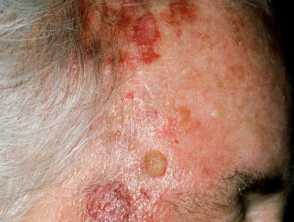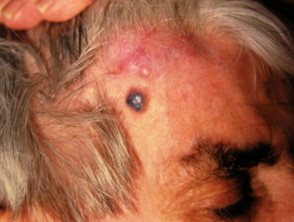What is an angiosarcoma?
Angiosarcoma is an uncommon and aggressive malignant tumour (cancer) that arises from endothelial cells, which normally line the walls of blood or lymphatic vessels.
- Haemangiosarcomas start in blood vessel walls.
- Lymphangiosarcomas start in lymph vessel walls.
Angiosarcomas may occur in any organ of the body but are more frequently found in skin and soft tissue. They can also originate in the liver, breast, spleen, bone or heart.
After they have been surgically excised, angiosarcomas:
- Often recur locally
- Spread systemically, with a high rate of lymph node metastases
- Have a poor prognosis and a high death rate.
Angiosarcoma
Who gets angiosarcoma?
Angiosarcoma is twice as common in men than in women. Angiosarcoma of the head and neck mostly affects older people.
The tumour may develop as a complication of a pre-existing condition. Certain patient groups may be at greater risk of developing angiosarcomas. These include:
- Patients with chronic lymphoedema (accumulation of lymph fluid in the arms) whom have undergone a radical mastectomy for breast cancer (removal of breast and all lymph nodes under the arm)
- Radiotherapy patients (especially those who have been exposed to radiation emitting contrast agent Thorotrast — this agent is no longer used but angiosarcomas have occurred in people decades after exposure)
- Patients with foreign material (such as Dacron, shrapnel, steel, and plastic) in the body
- Patients exposed to environmental agents such as sprays containing arsenic, and vinyl chloride used in the plastic industry.
What causes angiosarcoma?
The cause of the rapid proliferation and infiltration of malignant endothelial cells in angiosarcoma is usually unknown.
What are the signs and symptoms of angiosarcoma?
The signs and symptoms of angiosarcoma differ according to the location of the tumour. Often symptoms of the disease are not apparent until the tumour has become more advanced.
Soft tissue symptoms include:
- Rapidly growing tumour in the extremities or abdomen
- Abdominal tumours may grow to large sizes before being detected as the abdomen can accommodate tumours
- Haemorrhage, anaemia, haematoma, and gastrointestinal bleeding
- Enlarged adjacent lymph nodes.
Symptoms present on the skin include:
- Enlarging bruise, a blue–black nodule, or unhealed ulceration
- Lesions may bleed and be painful
- Angiosarcomas occurring on the head and neck in elderly people are one of the most common forms of cutaneous angiosarcoma
Angiosarcoma can also go on to affect the bones as well.
- Tumours may grow on multiple bones of the same extremity.
- Pain and tenderness of the affected area is common.
- Swelling and increased size of the affected limb may be present.
Angiosarcoma in the breast presents as a palpable mass without tenderness. Tumours often grow deep within breast tissue, causing diffuse breast enlargement with associated bluish skin discolouration.
Hepatic symptoms of angiosarcoma can vary and are nonspecific, and can include fatigue, weight loss and pain in the right upper quadrant. Angiosarcoma in the lungs can cause chest pain, bloody sputum, weight loss, cough, and difficulty with breathing
Cutaneous angiosarcoma
Cutaneous angiosarcoma is the most common form of angiosarcoma not associated with chronic lymphoedema. The disease is primarily located on the head and neck of elderly persons and is also known as Wilson–Jones angiosarcoma, senile angiosarcoma or malignant angioendothelioma.
Clinical features of this form of angiosarcoma are lesions, that most commonly appear on the scalp or upper forehead.
- In the early stages of disease, lesions may be singular or multifocal, slow spreading patches of livid or dusky red colour, somewhat like an ill-defined bruise.
- Lesions may develop into elevated nodules or plaques that may bleed and ulcerate.
- Lesions grow rapidly and spread, making margins difficult to define.
What is the treatment of angiosarcoma?
Treatment of angiosarcoma is dependent on the location of the angiosarcoma and the extent of the tumour. Treatment includes chemotherapy, surgery, radiotherapy, or a combination of these treatment modalities.
The optimum treatment of cutaneous angiosarcoma has not been defined. These angiosarcomas are difficult to treat because of their multifocal nature and extensive spread pattern. Radical surgery and postoperative radiotherapy is generally used but tumour recurrence is common after treatment. Despite aggressive treatment, prognosis is often poor.
Paclitaxel is a potent antiangiogenic drug that shows promise in the management of angiosarcoma when administered weekly.

